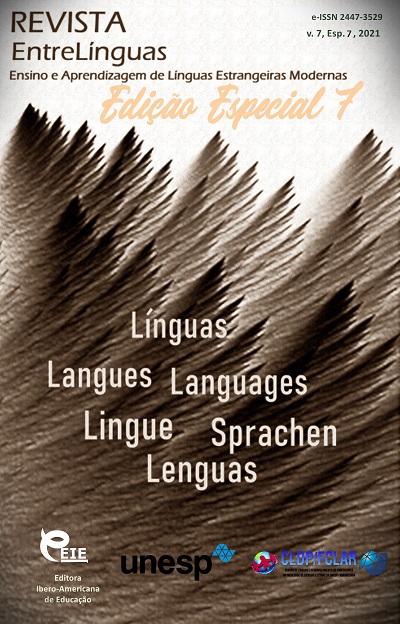The problem of loneliness in the modern society through the lens of the author’s worldview
DOI:
https://doi.org/10.29051/el.v7iesp.7.16281Keywords:
Linguistic worldview, Artistic worldview, Author’s individual concept, Nominative field, Figurative features, Axiological componentAbstract
Studying the problem of loneliness through the lens of the author’s consciousness enables us to understand the principles of the relationships between people in the modern world and what should be a priority in it and also allows to determine the ways of promoting moral values through the author’s word picture and artistic images. The ambiguity of approaches to the methods of linguistic and speech representation of artistic concepts has determined the purpose of this work as modeling the concept “Loneliness”, the features of which in A. Gavalda’s novel “Hunting and Gathering” (“Ensemble, c’est tout”) reflect the peculiarities of the author’s idiostyle and her attitude to the social phenomenon under study. The semantic-cognitive and contextual analysis reveal the main features of the concept that are characteristic of A. Gavalda’s cognitive consciousness as a representative of the contemporary French society. The study reveals the specificity of the figurative component of the concept, characterized by a high degree of abstractness, analyzes the peculiarities of the structural space of the investigated conceptual sphere, and provides an evaluative characteristic of loneliness. The authors of this paper note that the studied concept acquires an individual perspective primarily at the level of its contextual representation. An analysis of the artistic images created by the writer makes it possible to determine the original means that she uses to express her position.
Downloads
References
ALEFIRENKO, N.F. Language, Cognition and Culture: Cognitive-Semiological Synergetics of the Word. Volgograd, Publ. «Peremena», 228 p. 2006.
APRESYAN, YU.D. Selected Works. Vol. II. Integral description of the language and systemic lexicography. M., Publ. Languages of the Russian Culture, 768 p. 1995.
Bespalova, O.E. The concept of poetry by N.S. Gumilyov in its lexical presentation. Abstract. dis. ... cand. philol. sciences. SPb., 24 p. 2002.
BOGAERTS, S., VANHEULE, S., DESMET, M. Feeling of subjective emotional loneliness: an exploration of attachment. Social behavior and personality. N 34. P. 797-812 https://www.researchgate.net/publication/233512750 [accessed Jan 15 2021]. 2006.
BOLDYREV, N.N. Cognitive semantics. Tambov, Publ. house of Derzhavin Tambov State University, 123 p. 2000.
DOLNIK, J. Das axiologische Konzept und die axiologischen Wortfelder [The Axiological Concept and the Axiological Word-Fields]. Zeitschrift für Slawistik, Bd. 39. № 4. S. 504-513. 1994.
GAVALDA, A. Ensemble, c’est tout. 2004.
GAVALDA, A. Hunting and Gathering. Translated from the French by Alison Anderson. Riverhead Books, New York. 488 p. 2007.
GORBUNOVA, N.G. Linguistic creativity of J. Joyce: word-formation aspect (on the example of the novel “Ulysses”). Dis. ... cand. philol. sciences. SPb., 204 p. 2006.
http://ekladata.com/FlEcYIO7YwqB_sKaH0D9Qra7d08/Ensemble_c_39_est_tout_-_Anna_Gavalda.pdf [accessed Jan 16 2021].
http://www.kkoworld.com/kitablar/anna-qavalda-sadece-birlikde-kko-eng.pdf [accessed Jan 16 2021].
KARASIK, V.I. Cultural concepts: the problem of values. Language personality: cultural concepts. Collection of Scientific Works. Volgograd, “Peremena”. P. 3-16. 1996.
KILLEN, C. Loneliness: An Epidemic in Modern Society. Journal of Advanced Nursing, 28 (4): 762-770. 1998.
LOMONOSOVA, YU.E., SOBOLEVA, T.E. Image of war in Maurice Druon’s novels./ Issues in journalism, education, linguistics. № 4. Vol. National Research University «BelSU», Publishing House «BelSU». P.630-640. 2020.
LOTMAN YU.M. Rhetoric. In: Proceedings on sign systems. Vol. 12: Structure and semiotics of literary text. Studies of the Tartu University, 515:8-28. 1981.
MEYLAKH, B.S. Philosophy of Art and Artistic Picture of the World // Problems of Philosophy, 7: 116–125. 1983.
MILLER, L.V. Artistic concept as a semantic and aesthetic category. The World of Russian Word, 4: 39–45. 2000.
MINIKHANOVA, L.K., FATKULLINA, F.G. An artistic picture of the world as a special way of reflecting reality. Bulletin of the Bashkir State University, 3: 1626–1627. 2012.
SOBOLEV P.V. The Artistic Culture of the Person. L., Publ. Znanie, 32 p. 1986.
TIKHONOV, G.M. Phenomenon of loneliness: existential aspect. www.gramota.net/materials/3/2013/1-1/47.html] [accessed Jan 14 2021]. 2013.
Downloads
Published
How to Cite
Issue
Section
License

This work is licensed under a Creative Commons Attribution-NonCommercial-ShareAlike 4.0 International License.
Os manuscritos aceitos e publicados são de propriedade da Revista EntreLínguas. Os artigos publicados e as referências citadas na Revista EntreLínguas são de inteira responsabilidade de seus autores.
Transferência de direitos autorais – autorização para publicação
Caso o artigo submetido seja aprovado para publicação, já fica acordado que o(s) autor(es) autoriza(m) a UNESP a reproduzi-lo e publicá-lo na EntreLínguas, entendendo-se os termos “reprodução” e “publicação” conforme definição respectivamente dos incisos VI e I do artigo 5° da Lei 9610/98. O artigo poderá ser acessado pela rede mundial de computadores (Internet), sendo permitidas, a título gratuito, a consulta e a reprodução de exemplar do artigo para uso próprio de quem a consulta, desde que haja a citação ao texto consultado. Essa autorização de publicação 328 EntreLínguas, Araraquara, v. 1, n .2, p. 323-328, jul./dez. 2015 não tem limitação de tempo, ficando a UNESP responsável pela manutenção da identificação do(s) autor(es) do artigo. Os artigos publicados e as referências citadas na Revista EntreLínguas são de inteira responsabilidade de seus autores.











